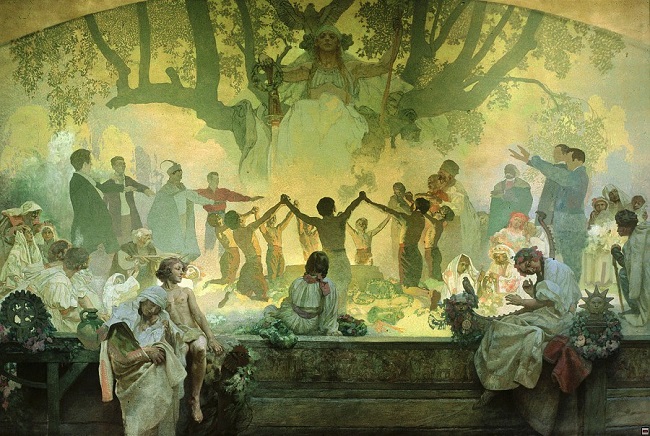
Praha will be able to place Mucha's Epopee in Savarin for 25 years with a five-year option
 |
Prague/Moravský Krumlov – The capital city will be able to place the Slav Epic by Alfons Mucha in the Savarin Palace on Wenceslas Square for 25 years with a five-year option. At the same time, a dispute with one of the heirs, John Mucha, will be resolved, and there will also be space for displaying the family collection. The operation and management will be the responsibility of the developer, Welwyn, or one of its firms. This follows from the draft agreement between Prague, the Mucha Foundation, and Welwyn, which was approved by the Prague councilors today.
The cycle consists of 20 large canvases that Mucha painted over 18 years starting in 1910. Since last year, they have been loaned to Moravský Krumlov for the next five years, where they have been exhibited before. "We have a contract with Prague until the end of 2026. Prague wants to find its own exhibition space for the epic by then, and the Savarin Palace is one of the options. The epic is in our care, and if Prague does not have space, we will be willing to negotiate a possible extension of the exhibition in Krumlov," said Krumlov Mayor Tomáš Třetina (TOP 09) to ČTK.
The rental period in Savarin will be 25 years, and the capital city will have the option to extend the lease period once for another five years, under the same conditions unless the city and developer agree otherwise. According to the wording of the agreement, Welwyn will complete the construction of a permanent exhibition within four years from receiving the final decision about the placement of the Savarin Palace. The zoning decision was issued in March 2020, but it has not yet come into legal force.
The agreement entails the conclusion of a long-standing dispute between John Mucha and the capital city regarding the ownership of the canvases. In the event of signing the agreement, according to its wording, Mucha will commit to recognizing the city's ownership rights to the canvases within 30 days of signing and withdraw his lawsuits. Prague, on the other hand, commits to not relocating the paintings anywhere other than its own exhibition spaces designated solely for the epic, as wished by the painter Alfons Mucha.
The exhibition will also include space for displaying the family collection. None of the other parts of the permanent exhibition will be allowed to disrupt the artistic impression of the epic, both from a technical and artistic perspective. The hall where the epic will be displayed should, according to the document, be 23 meters wide and more than 60 meters long. The canvases should be placed opposite each other, with about a fifteen-meter space between them.
The proceeds from the operation of the permanent exhibition, namely from ticket sales and other activities, will be collected for Prague, specifically for the Gallery of the Capital City, and the Mucha Foundation. The funds will be used to cover direct costs of operation and management of the exhibition. The operating costs of the permanent exhibition are estimated at 539 crowns per square meter per month according to the document. These include, among other things, estimated costs for staff including security and ensuring safety, maintenance, which will include possible restoration and monitoring of the works, or marketing.
The first 11 canvases of the epic were exhibited in 1919 at the Clementinum in Prague, and from 1920 to 1921 they achieved success at exhibitions in New York and Chicago. The entire epic was exhibited for the first time in 1928 at the Trade Fair Palace in Prague, and the paintings were placed under the administration of the Gallery of the Capital City of Prague. In 1933, the canvases were rolled up and stored in deposit. It was not until 1963 that they were exhibited again at the castle in Moravský Krumlov. After 1989, however, the castle, which previously housed a railway vocational school, fell into disrepair.
The English translation is powered by AI tool. Switch to Czech to view the original text source.
0 comments
add comment
Related articles
0
25.10.2022 | Granddaughter of Mucha: Leave the decision about the epic to the new leadership of Prague
0
13.02.2022 | The Slavic Epic by Alfons Mucha will be installed in the Savarin Palace in Prague
0
02.08.2021 | There is interest in the Slav Epic in M. Krumlov, tickets are almost sold out
0
19.04.2021 | Moravskokrumlov councilors approved the loan agreement for the Slav Epic
0
12.01.2021 | Crestyl offered to place Mucha's Epic in Savarin for free in Prague
2
05.01.2021 | Muchova epic could be in Savarin for 25 years
0
09.09.2020 | Prague will establish a commission for the placement of Mucha's Slav Epic
0
02.09.2020 | The adjustments to the castle are culminating, the Slavic Epic will arrive at the turn of the year
0
21.09.2011 | Moravský Krumlov wants to convince Prague not to take away the epic












